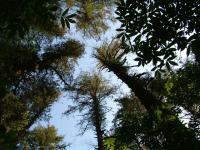
Core Research Areas
- Disease distribution & severity: Aerial survey & permanent monitoring plots
- Biology, ecology & epidemiology of Nothophaeocryptopus gaeumannii
- Effect of silvicultural treatments on disease
- Tree Improvement (in collaboration with other coops & agencies)
- Models to predict growth impacts & geographic distribution of disease severity
- Integrated Pest Management of Swiss needle cast
- SNCC Report - The Swiss Needle Cast Cooperative Research and Monitoring Plot Network: multiple opportunities for research.
Current Project Summaries (2020)
*for detailed reports on these and other ongoing projects, please see the SNCC Annual Report 2018
Aerial Survey
- Conducted in cooperation with Sarah Navarro, Danny Norlander and others at the Oregon Department of Forestry, Zach Heath, Ben Smith, Justin Hoff (Forest Health Protection, USDA Forest Service), Dan Omdal, Alexandar Dozic, Glenn Kohler (Washington Department of Natural Resources).
- Represents a key component of our disease monitoring program, which is considered crucial to our Integrated Pest Management Strategy for Swiss needle cast (SNC).
- Objectives:
- To track the distribution and severity of SNC in the Oregon Coast Range, Washington Coast Range and Oregon Cascade Range biennially to determine whether:
- the area impacted by the SNC epidemic is expanding, retracting or remaining constant over time.
- disease severity is increasing, decreasing or remaining constant within the epidemic area over time.
- To track the distribution and severity of SNC in the Oregon Coast Range, Washington Coast Range and Oregon Cascade Range biennially to determine whether:
- Methods:
- The Coast Range survey is flown late-April to early- June and covers ~ 4 million acres of forest in Oregon and 2.7 million acres in Washington.
- The observation plane flies 1,500 to 2,000 ft above the terrain, following north-south lines separated by 2 miles.
- Observers look for areas of Douglas-fir forest with obvious yellow to yellow-brown foliage, a symptom of SNC. Patches (“polygons”) of forest with these symptoms are sketched onto computer touch screens displaying topographic maps or ortho-photos and the position of the aircraft.
- Each polygon is classified for degree of discoloration as either “S” (severe) or “M” (moderate).
- The Oregon Coast Range survey area generally extends from the Columbia River south to Brookings near the California border, and from the coastline eastward until obvious symptoms were no longer visible (historically, ~30 miles). Partial survey of the Oregon Cascades Range covers Lane, Linn, Marion, and Clackamas counties. The Washington survey area extends from the Columbia River in Washington north to the Straight of Juan de Fuca, and from the coastline eastward.
- Products: The results of the annual aerial survey are presented in the form of an aerial survey map (available in GIS format) and as a measure of the total acreage of stands with visible SNC symptoms (estimated as moderate or severe). Maps are available on Oregon Department of Forestry and SNCC websites.
SNCC Research and Monitoring Plot Network: multiple opportunities for research.
Swiss needle cast (SNC), a foliar disease affecting Douglas-fir (Pseudotsuga menziesii (Mirb.) Franco) in the Pacific Northwest, is caused by the ascomycete fungus Nothophaeocryptopus gaeumannii. (T. Rohde) Videira et al. Disease severity and growth impacts are assessed using the number of years of retained foliage. Growth declines occur due to foliar loss, and previous analyses have shown that stands averaging 1-year of foliage retention typically exhibit growth losses exceeding 50% (fig 1). In 2013, the installation of a network of research and monitoring plots was initiated, eventually totaling 106 plots located from the Oregon-California border to SW Washington and within 35 miles of the coast. These plots were envisioned to provide sites for numerous investigations, including regional monitoring of the extent and severity of SNC, the effect of the disease on Douglas-fir growth and stand dynamics, determination of how infection varies with environmental variables, and its connection to soil or foliar chemistry (Lan et al. 2019). Among the objectives of our research was to confirm the relationship between foliage retention and disease severity and determine how this relationship varies with elevation. A second objective was to determine the relationship between SNC infection levels and Douglas-fir cubic volume growth, based on the remeasurement data collected from 66 permanent plots remeasured thus far (0.08 ha).
Methods
The SNC Cooperative research and monitoring plot network was established between the California border and SW Washington (338 miles) and 35 miles inland from the coast in the fall of 2013, 2014, and 2015 (fig 2). Precipitation and temperature vary across the region, with annual precipitation ranging from 1200 - 4800 mm, primarily from October through May, and mean annual temperature ranging from 13 - 18°C. The elevation of plots making up the network ranged from 40 – 800 meters above sea level.
Field Methods
Foliage samples were collected on each research plot just prior to budbreak (March-May) in the spring following plot installation (2014, 2015, and 2016). In each plot, foliage samples were collected from the south side of the mid-crown of the 5 – 10 largest (by dbh) undamaged trees. Foliage samples were transported to the lab for pseudothecial occlusion counts. Foliage retention was evaluated in the field by estimating the number of annual cohorts of foliage remaining on the 4-year-old lateral branch (Maguire et al. 2011) (nearest 10% for each needle cohort). Sixty-six of the 106 plots were remeasured in fall of 2018 and 2019 after 4 – 5 years of growth. The remaining plots will be remeasured in fall 2020.
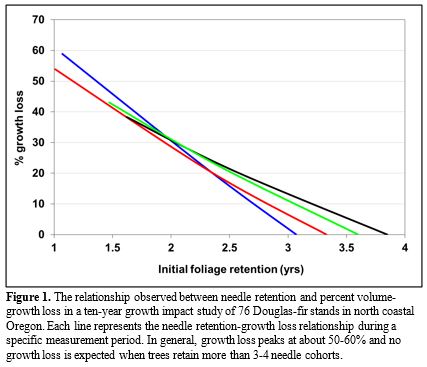
Laboratory Methods
Pseudothecial Occlusion
The degree of fungal colonization was determined visually by estimating the percent of stomates occluded by N. gaeumannii pseudothecia on each needle. For each selected tree, 50 needles were selected from three 2-year-old cohorts (branchlets) of each 4-year lateral branch. The needles were taped to an index card, and each needle was visually inspected with a dissecting microscope to determine proportion of needles with stomates occluded by pseudothecia, referred to as SNC incidence. The proportion of pseudothecia emerging from stomata (pseudothecial density) were recorded for the first 10 needles with positive incidence. Pseudothecial density was visually observed and averaged in three randomly chosen locations (tip, middle, and base) of each of the 10 needles, following methodology described by Manter et al. (2000) and Winton et al. (2002). The SNC disease severity index was calculated by multiplying the percentage of occluded stomata (pseudothecial density) by incidence of needles with pseudothecia (Manter et al. 2000).
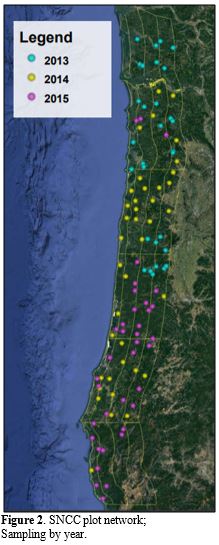
Results and Discussion
The series of graphs confirmed the positive relationship between foliage retention, disease severity index, and elevation (fig 3, 4). With the Coast Range running parallel with the coast, increased elevation is associated with greater distance from the coast and from areas previously identified as being particularly affected by SNC (Hansen et al. 2000). Greater elevations are also associated with cooler winter temperatures that have been hypothesized to slow over-winter pseudothecial development (Manter et al. 2005, Ritóková et al. 2016), decreases in soil nitrogen that have been found to be associated with greater foliage retention (Hatten et al. 2018), and greater summer temperatures associated with continentality and reduced SNC levels (Zhao et al. 2011). A stand-level regression analysis of the growth of these plots correlated periodic annual cubic volume growth with Douglas-fir basal area, basal area of other conifers, basal area of hardwoods, an SNC-adjusted estimate of site index (Bruce 1981), and average stand foliage retention. Estimates of site index based on height-age pairs were adjusted by an equation correlating foliage retention and height increment (unpublished). The implied cubic volume growth loss due to high SNC (low foliage retention) was estimated to be as high as 40% when foliage retention was as low as 1.0 years (fig 5). This maximum growth loss estimate was not as high as estimates based on the volume growth-foliage retention relationships established during four separate growth periods between 1998 and 2008 on a previous set of permanent plots. Maximum growth losses estimated during the 1998-2008 growth periods exceeded 50%. The smaller value from the current analysis may be due to a difference in the sampled population. In the time between the original 1998 plot establishment and the 2013 establishment of replacement plots, many underperforming pre-merchantable coastal stands have been harvested and replanted to western hemlock. As a result, it is believed that areas particularly subject to the highest levels of SNC no longer have significant Douglas-fir stands in the target age range, and are thus not represented in the sampled population.
If severity index is included as a covariate in the stand level regression analysis, it is also a significant predictor, indicating the degree to which pseudothecial occlusion is the driving force in growth losses. Foliar loss is the result of extreme occlusion, but partially occluded needles remain only partially functional as gas exchangers. At a given level of foliage retention, there is large variation in the degree of pseudothecial occlusion (fig 6), and the two factors together are related to cubic volume growth loss (fig 7).
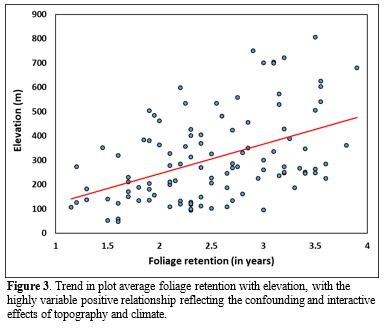
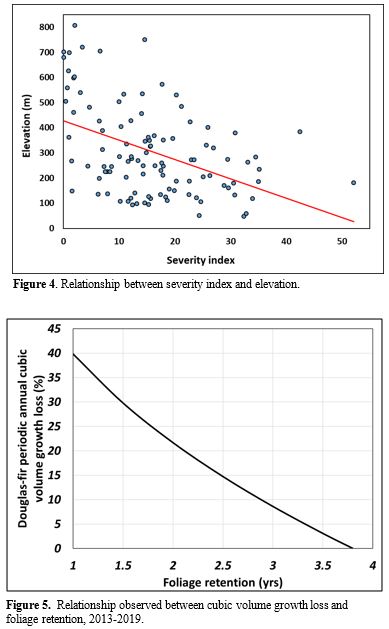
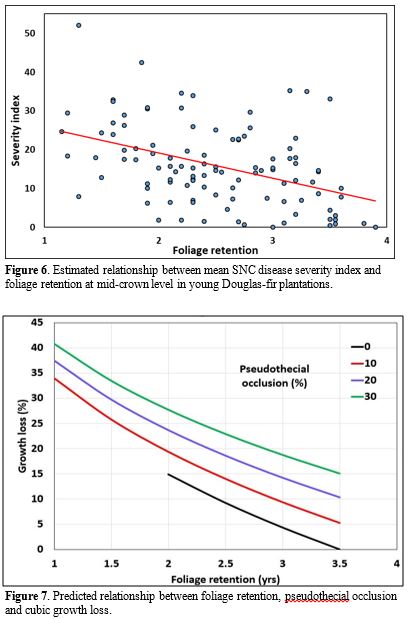
Literature Cited
Bruce, D., 1981. Consistent height-growth and growth-rate estimates for remeasured plots. Forest Sci. 27: 711-725.
Hansen E.M., Stone J.K., Capitano B.R., Rosso P., Sutton W., Kanaskie A., McWilliams M.G.. 2000. Incidence and impact of Swiss needle cast in forest plantations of Douglas-fir in coastal Oregon. Plant Disease. 84:773-779.
Hatten, J., Frey, D., Lan, Y., Ritóková, G, Shaw, D. Modeling the severity and impact of SNC in Douglas-fir from soil and climate variables in coastal western Oregon and southwestern Washington. Swiss Needle Cast Cooperative Annual Report 2018: 38-45.
Lan, Y-H, D.C. Shaw, G. Ritóková, J. Hatten. 2019. Associations between Swiss needle cast severity and foliar nutrients in young-growth Douglas-fir in coastal western Oregon and southwestern Washington, USA. Forest Science doi: 10.1093/forsci/fxz022
Maguire, D.A., D.B. Mainwaring, and A. Kanaskie. 2011. Ten-year growth and mortality in young Douglas-fir stands experiencing a range in Swiss needle cast severity. Canadian Journal of Forest Research 41: 2064-2076.
Manter D.K., Bond B.J., Kavanagh K.L., Rosso P.H., Filip G.M. 2000. Pseudothecia of Swiss needle cast fungus, Phaeocryptopus gaeumannii, physically block stomata of Douglas-fir, reducing CO2. New Phytologist. 2000:481-491.
Manter D.K., Reeser P.W., Stone J.K.. 2005. A climate-based model for predicting geographic variation in Swiss needle cast severity in the Oregon Coast Range. Phytopathology. 95:1256-1265.
Ritóková, G., Shaw, D.C., Filip, G., Kanaskie, A., Browning, J., and D. Norlander. 2016. Swiss Needle Cast in Western Oregon Douglas-Fir Plantations: 20-Year Monitoring Results. Forests 7, 155.
Winton L.M., Stone J.K., Watrud L.S., Hansen E.M.. 2002. Simultaneous one-tube quantification of host and pathogen DNA with real-time polymerase chain reaction. Phytopathology. 92:112-116.
Zhao, J., Mainwaring, D.B., Maguire, D.A., Kanaskie, A. 2011. Regional and annual trends in Douglas-fir foliage retention: Correlations with climatic variables. Forest Ecology and Management. 262:1872-1886.